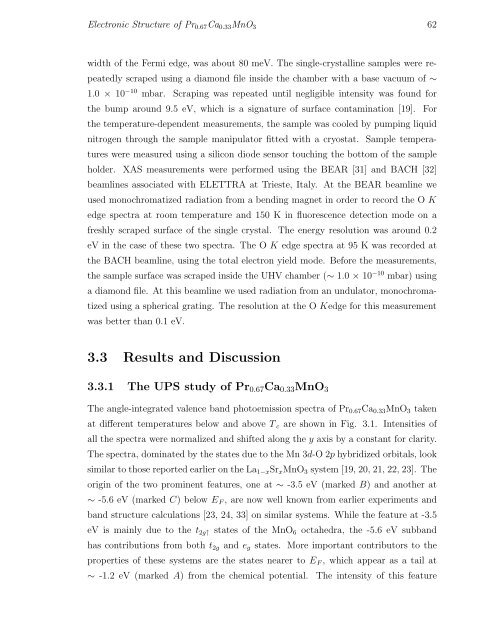PHYS07200604007 Manas Kumar Dala - Homi Bhabha National ...
PHYS07200604007 Manas Kumar Dala - Homi Bhabha National ...
PHYS07200604007 Manas Kumar Dala - Homi Bhabha National ...
You also want an ePaper? Increase the reach of your titles
YUMPU automatically turns print PDFs into web optimized ePapers that Google loves.
Electronic Structure of Pr 0.67 Ca 0.33 MnO 3 62<br />
width of the Fermi edge, was about 80 meV. The single-crystalline samples were repeatedly<br />
scraped using a diamond file inside the chamber with a base vacuum of ∼<br />
1.0 × 10 −10 mbar. Scraping was repeated until negligible intensity was found for<br />
the bump around 9.5 eV, which is a signature of surface contamination [19]. For<br />
the temperature-dependent measurements, the sample was cooled by pumping liquid<br />
nitrogen through the sample manipulator fitted with a cryostat. Sample temperatures<br />
were measured using a silicon diode sensor touching the bottom of the sample<br />
holder. XAS measurements were performed using the BEAR [31] and BACH [32]<br />
beamlines associated with ELETTRA at Trieste, Italy. At the BEAR beamline we<br />
used monochromatized radiation from a bending magnet in order to record the O K<br />
edge spectra at room temperature and 150 K in fluorescence detection mode on a<br />
freshly scraped surface of the single crystal. The energy resolution was around 0.2<br />
eV in the case of these two spectra. The O K edge spectra at 95 K was recorded at<br />
the BACH beamline, using the total electron yield mode. Before the measurements,<br />
the sample surface was scraped inside the UHV chamber (∼ 1.0 × 10 −10 mbar) using<br />
a diamond file. At this beamline we used radiation from an undulator, monochromatized<br />
using a spherical grating. The resolution at the O Kedge for this measurement<br />
was better than 0.1 eV.<br />
3.3 Results and Discussion<br />
3.3.1 The UPS study of Pr 0.67 Ca 0.33 MnO 3<br />
The angle-integrated valence band photoemission spectra of Pr 0.67 Ca 0.33 MnO 3 taken<br />
at different temperatures below and above T c are shown in Fig. 3.1. Intensities of<br />
all the spectra were normalized and shifted along the y axis by a constant for clarity.<br />
The spectra, dominated by the states due to the Mn 3d-O 2p hybridized orbitals, look<br />
similar to those reported earlier on the La 1−x Sr x MnO 3 system [19, 20, 21, 22, 23]. The<br />
origin of the two prominent features, one at ∼ -3.5 eV (marked B) and another at<br />
∼ -5.6 eV (marked C) below E F , are now well known from earlier experiments and<br />
band structure calculations [23, 24, 33] on similar systems. While the feature at -3.5<br />
eV is mainly due to the t 2g↑ states of the MnO 6 octahedra, the -5.6 eV subband<br />
has contributions from both t 2g and e g states. More important contributors to the<br />
properties of these systems are the states nearer to E F , which appear as a tail at<br />
∼ -1.2 eV (marked A) from the chemical potential. The intensity of this feature
















